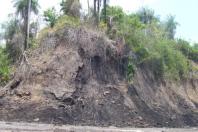Oil shale: Solution to Mongolia’s imported fuel dependency?
Oil shale: Solution to Mongolia’s imported fuel dependency?
By B.Khash-Erdene
April 9, 2013
It is estimated that Mongolia has and 800 billion tons of oil shale reserves. But this number was deduced by Mongolian geologists by studying only 19 percent of the outlined reserves in 1990.
Oil shale is said to be an alternative fuel source which provides a vast potential for profit to businessmen and entrepreneurs. Although Mongolia hasn’t even fully established its reserves of this possible miraculous mineral, foreign businesses have already begun eyeing Mongolia’s shale deposits.
MAK of Mongolia, USA’s Genie Oil & Gas, and France’s Total have introduced to the Ministry of Mining’s Petroleum Authority their pre-feasibility studies and even plans to extract petroleum from oil-bearing shale, shale deposits which contain petroleum, according to local newspapers.
Their pre-feasibility studies state that it would cost around 350 MNT to produce one liter of high quality (Euro-4 Standard of European emission standards for light commercial vehicles) diesel. When transportation costs, taxes, turnover, and other factors are added to the production, the fuel could be sold at a maximum price of 1,000 MNT per liter.
The relevant companies said that all they need from the government to produce cheaper high quality fuel is a business-friendly environment that supports the use of high tech equipment, and meets health and safety regulations.
According to the Deputy Minister of Mining, O.Erdenebulag, the American method of extraction will be used to produce fuel from oil shale. He added that the Ministry is planning to create a production contract in the near future which will make it possible for Mongolia to use domestically-produced fuel within the next two years.
If all goes well, the production cycle can start which will make it possible to produce 6,700 tons of fuel, petroleum products, natural gas, and other synthetic materials by 2018, mentioned O.Erdenebulag.
The trial factory is most likely to be built in Tuv (Central) Province or Dornogobi Province which is already a hotspot for foreign investors due to the giant OyuTolgoi mine. The full mine and extraction factory facility is estimated to require around four billion USD. The companies even estimated how much they would contribute to the state through taxes, which is around 850 million USD per annum.
The project is estimated to create 5,000 job positions directly and indirectly, according to Genie Oil & Gas. The company has oil shale factories in Colorado, USA and Israel through its wholly-owned subsidiary, Genie Energy.
The oil shale processing factory will allow Mongolia to meet its own fuel demand as well as provide an opportunity to export value-added goods which will affect Mongolia’s economy very favourably.
“Producing fuel from oil shale is much cheaper than extracting fuel from coals,” said the Minister of Mining, D.Gankhuyag.
Experts in this matter have said that if Mongolia builds its own petroleum processing as well as an oil shale factory, it would be as if you had a Khos Mori (pair of horses). Mongolia doesn’t have much practical knowledge and experience when it comes to oil shale production besides theoretical. Therefore, plans to send trainees to study shale in the USA and France are being made. If the contract for oil shale production is made, the companies will take care of training specialists.
About oil shale
Oil shale, also known as kerogen shale, is an organic-rich fine-grained sedimentary rock containing kerogen (a solid mixture of organic chemical compounds) from which liquid hydrocarbons called shale oil (not to be confused with tight oil – crude oil occurring naturally in shale) can be produced. Shale oil is a substitute for conventional crude oil. However, extracting shale oil from oil shale is more costly than the production of conventional crude oil both financially and in terms of its environmental impact. Deposits of oil shale occur around the world, including major deposits in the United States. Estimates of global deposits range from 2.8 to 3.3 trillion barrels (450×109 to 520×109 m3) of recoverable oil.
Heating oil shale to a sufficiently high temperature causes the chemical process of pyrolysis to yield a vapor. Upon cooling the vapor, the liquid shale oil –an unconventional oil – is separated from combustible oil-shale gas (the term “shale gas” can also refer to gas occurring naturally in shales). Oil shale can also be burned directly in furnaces as a low-grade fuel for power generation and district heating or used as a raw material in chemical and construction-materials processing.
Oil shale gains attention as a potential abundant source of oil whenever the price of crude oil rises. At the same time, oil-shale mining and processing raise a number of environmental concerns, such as land use, waste disposal, water use, waste-water management, greenhouse-gas emissions, and air pollution. Estonia and China have well-established oil shale industries. Brazil, Germany, and Russia also utilize oil shale.
As of 2008, certain industries in Brazil, China, Russia, Estonia, and, to some extent, Germany use oil shale. Several additional countries started assessing their reserves or built experimental production plants, while others phased out their oil shale industry. Oil shale serves for oil production in Estonia, Brazil, and China; for power generation in Estonia, China, and Germany; for cement production in Estonia, Germany, and China; and for use in chemical industries in China, Estonia, and Russia.
As of 2009, eighty percent of oil shale used globally is extracted in Estonia, mainly due to oil-shale-fired power plants. These power plants in Estonia have an installed capacity of 2,967 megawatts (MW). They are also present in China (12 MW) and Germany (9.9 MW). Israel, Romania, and Russia have in the past ran power plants fired by oil shale, but have shut them down or switched to other fuel sources such as natural gas. Jordan and Egypt plan to construct power plants fired by oil shale, while Canada and Turkey plan to burn oil shale along with coal for power generation. Oil shale serves as the main fuel for power generation only in Estonia, where the oil-shale-fired Narva Power Plants accounted for 95 percent of country’s electricity generation in 2005.
According to the World Energy Council, the total production of shale oil from oil shale in 2008 was 930,000 tons, equal to 17,700 barrels per day; of which China produced 375,000 tons, Estonia 355,000 tons, and Brazil 200,000 tons. In huge comparison, production of the conventional oil and natural gas liquids in 2008 amounted to 3.95 billion tons or 82.12 million barrels per day.
http://ubpost.mongolnews.mn/?p=3553


